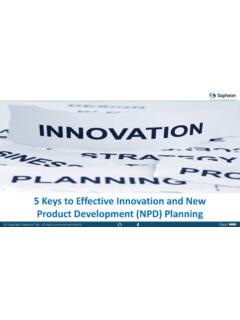Transcription of An Introduction to Strategic Roadmapping
1 An Introduction to Strategic Roadmapping White Paper An Introduction to Strategic Roadmapping An Introduction to Strategic Roadmapping ..3. What is Roadmapping ? ..3. Why Engage in Roadmapping ?..3. Strategic Roadmapping 101 ..3. Benefits of Strategic Roadmapping ..4. Roadmapping as a Business Process ..4. Market Product Roadmaps ..5. Technology Composite Roadmaps ..6. Strategy Alignment ..6. Roadmapping in the Real World Use Case Scenarios ..6. Develop a Cross-Functional, Integrated Strategy with Roadmapping with software ..7. Take the Next Step Towards Enterprise-Wide Strategy Alignment ..9. Sources ..10. About Sopheon ..10. 2. An Introduction to Strategic Roadmapping An Introduction to Strategic Roadmapping What is Roadmapping ? Roadmapping is the discipline that drives improved decision making by integrating enterprise information from across functions into a set of integrated and interdependent plans used to direct strategies for innovation, product development, technology advances, and operations/.
2 Supply chain throughout an entire organization. Roadmapping allows the organization to clearly communicate plans to enable a focus on fewer, bigger and better products that provide the best return on innovation investment. As a Strategic planning process it increases transparency, making it easier to model future scenarios with multiple resource investment opportunities. Executives go beyond gut feeling and are truly informed decision makers who can view alternatives, perform what-if analysis and proceed with the best course of action. 80% of executives Why Engage in Roadmapping ? Roadmapping is essential for business and Strategic alignment across an organization. say they have a gap According to Gartner Research, 80% of corporate executives recognize that they have a gap between strategy and between strategy and product development activity1.
3 Companies develop sound ideas and product development strong strategies but miss the crucial steps of communicating these learnings and securing buy-in from across the organization. Due to an overall lack of cross-functional communication Gartner Research and collaboration, the operational and product development areas of the business continue with the day-to-day status quo while the strategies defined by top-level executives fall by the wayside. Roadmapping solves this problem by aligning key cross-functional stakeholders, providing a powerful tool to develop business strategy and plan execution across a common element of time. These Strategic views of enterprise plans enable companies to identify potential shortfalls of growth goals and targets, and then to make better, more informed decisions about resource allocation and investment opportunities.
4 By highlighting gaps in the innovation and new product development (NPD) planning processes, Roadmapping yields valuable insights and increases an organization's agility when reacting to constantly changing market, product, and technology factors while formulating business strategy. The implementation Strategic Roadmapping 101. of Roadmapping in an As a proven best practice for projecting with precision into the future and aligning day-to-day organization should functions with business plans, Strategic Roadmapping involves manipulating the information contained in roadmaps to plan the best course of action for what's to come, linking actions be managed as a with tactical objectives. This enables decision-makers to gain a multidimensional view into the process improvement future and alter data to reveal the outcomes of their planning scenarios.
5 Of the current planning process and Creating a living, sustainable discipline of Roadmapping within your business requires support not an initiative unto for thinking of Roadmapping as a business process instead of an event. Roadmaps should not just be viewed as the output of a process, but rather as a rolling snapshot of strategy at its own. 2 any moment in time. Philip J. Whalen, PhD. Principal, Whalen Management Group By projecting far into the future with the confidence that calculated decisions are fueled by high-quality, up-to-date information, Strategic Roadmapping propels companies ahead in a common direction while providing decision-makers with the confidence that they are moving in the right direction. In fact, thousands of leading companies around the world, including 3. An Introduction to Strategic Roadmapping Motorola , Corning , Hewlett-Packard , and Lockheed Martin leverage Roadmapping to enhance planning processes that are responsible for sustaining and improving their business performance.
6 Roadmapping Benefits of Strategic Roadmapping has emerged as an Integrated cross-functional roadmaps increase organizational agility, enabling rapid extremely effective modification of product offerings to meet new market demands and adapting to changing customer needs, competitive threats, or regulatory conditions. It promotes in-depth process for creating collaboration between the company, customers, partners and suppliers. and visualizing relationships For instance, Strategic Roadmapping enables manufacturers to monitor the progress of all among business product development programs in real time and permits users to visualize where projects fit into the larger network of corporate development initiatives. It also increases cross-functional functions in visibility, an advantage that can help uncover opportunities for the reuse of technology across support of Strategic the organization.
7 Because redundant work is minimized and technology reuse is increased, technology there are fewer product delays and time-to-market improves. Roadmapping is an effective way planning. 3 to evaluate whether an organization's competencies and capabilities are improving over time. University of Cambridge With Strategic Roadmapping you can: Create optimal alignment between R&D and product development initiatives. Stretch planning horizons to enable proactive (vs. reactive) product planning. Grow product portfolio(s) in line with corporate objectives and market demands. Uncover gaps, challenges , and uncertainties in product, technology, and capability plans. Expose long-term Strategic weaknesses before they become critical. Clarify Strategic vision throughout the organization. Communicate and provide visibility into Strategic program direction across the organization.
8 Manage data, product plans, and goals at a high level, and then drill down for in-depth details. Link markets, products, technologies and capabilities. Roadmapping as a Business Process Roadmapping is a business process that involves capturing Strategic information on a timeline. This data typically relates to business vision, objectives, strategies, market requirements, product or service plans, technologies, and capabilities. The collected data is then fed into various roadmaps with links between elements. It's important as an organization to engage in Roadmapping regularly as opposed to the outdated practice of meeting once a year to discuss strategy so the company can be agile, nimble, and capable of rapidly adapting to change. Four questions to effectively jump-start an inter-departmental Roadmapping dialogue: 1. What do our customers need?
9 2. Can we view the current state and predicted future of our business ecosystem? 3. Do we have the right level of capabilities, programs, products and services in place? 4. How are we ultimately going to deliver these products and services? 4. An Introduction to Strategic Roadmapping Common types of roadmaps include market, product, technology, supplier, and composite. Typically, they reflect the planning horizon over multiple time periods. Time-based elements represent the availability of a technology, product, and market or decision-points. Even if the timing of an event is uncertain, placing this information in a time domain forces the enterprise to consider its implications. Figure 1: An example of a high-level composite roadmap. Today Tomorrow Beyond 0 - 1 Year 2 - 4 Years 5+ Years Market/ Roadmaps Existing Market/Programs Di erentiated Business Value Breakthrough Opportunities New Market/Programs Acquisitions/Divestitures Customer Collaboration Product Roadmaps Incremental Improvement Di erentiated Business Value Di erentiated Products Alternative Scenarios End of Life Technology Roadmaps Risk Mitigation Platform Transformation Disruptive Technologies Alternative Paths Make vs.
10 Buy Market Roadmaps When creating a market roadmap you are evaluating the environment of the marketplace to help identify potential long-term breakthrough opportunities. This environmental assessment takes into account trends and key needs that are driving the marketplace, external influences, and the competitive landscape, forcing the team to think about assumptions being made. Problems can be spotted in advance, giving the company time to react, plan, and start solving those problems. Product Roadmaps Product roadmaps are powerful tools that allow you to visualize product evolution plans and desired product attributes while pinpointing development gaps. It also helps create a business case to upper management to justify investment. Every enterprise This roadmap provides a comprehensive narrative with detailed predictions of product growth needs a process to including incremental improvements and larger releases across time and the complexities of building new product innovations.








